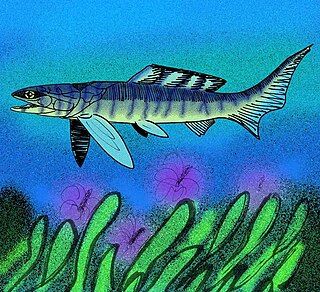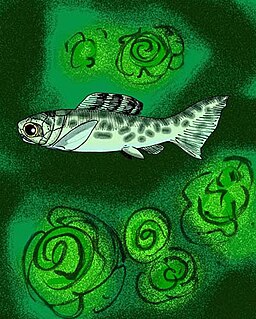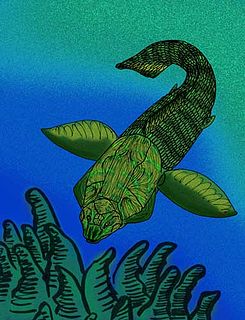
Rhenanida is an order of scaly placoderms. Unlike most other placoderms, the rhenanids' armor was made up of a mosaic of unfused scales and tubercles. The patterns and components of this "mosaic" correspond to the plates of armor in other, more advanced placoderms, suggesting that the ancestral placoderm had armor made of unfused components, as well.

Titanichthys is a genus of giant, aberrant marine placoderm from shallow seas of the Late Devonian of Morocco, Eastern North America, and possibly Europe. Many of the species approached Dunkleosteus in size and build. Unlike its relative, however, the various species of Titanichys had small, ineffective-looking mouth-plates that lacked a sharp cutting edge. It is assumed that Titanichthys was a filter feeder that used its capacious mouth to swallow or inhale schools of small, anchovy-like fish, or possibly krill-like zooplankton, and that the mouth-plates retained the prey while allowing the water to escape as it closed its mouth.

Homosteus is a genus of flattened arthrodire placoderm from the Middle Devonian. Fossils are found primarily in Eifelian-epoch aged strata of Europe, Canada, Greenland, and Estonia. All of the species had comparatively large, flattened heads with, as suggested by the upward opening orbits, upward-pointing eyes. These adaptations suggest that the various species were benthic predators.

Pseudopetalichthys problematica is a lightly armored pseudopetalichthyid placoderm from the Hunsrückschiefer Lagerstätte of Early Devonian Germany. The holotype and only known specimen is an articulated, but incomplete individual consisting of a large, mostly intact, plate-covered head, the bases of the pectoral fins, and most of the vertebral column, with a total length of 15 centimetres (6 in). The specimen superficially resembles Stensioella, though the structures of the mouth, and orbits, and placement of the gill rakers all differ.

Rhachiosteus pterygiatus is an extinct brachythoracid arthrodire placoderm from the Late Devonian of Germany. It is known only from a single specimen, which may be a larval or juvenile form, as the skull of said specimen is only 19 millimetres long.

Selenosteidae is a family of small to large-sized arthrodire placoderms from the Late Devonian. With the exception of the Chinese Phymosteus, selenosteids lived in shallow seas in what is now Eastern North America, Eastern Europe, and Northeastern Africa.

Selenosteus brevis is a large selenosteid arthrodire placoderm known from the Famennian Cleveland Shale of Ohio. Scrappy remains from the Frasnian Rhinestreet Shales of Erie County, New York, were attributed by Hussakof and Bryant to this genus in 1919, but, this identification is doubtful. A second species, S. kepleri, was described in 1901, but, not enough differences can be seen between its specimens, and those of the type species to warrant new species status.

Asterosteus is genus of rhenanid placoderm from the Eifelian. The type species, A. stenocephalus, is known from an incomplete skull from Middle Devonian strata of Ohio. What may be a second species is described from fragments decorated with star-shaped tubercules from the Eifelian-aged Gebze beds of Turkey.

Gymnotrachelus hydei is a large selenosteid arthrodire placoderm known from the Late Famennian Cleveland Shale of Ohio. It was originally reconstructed as physically resembling Selenosteus, with slightly smaller orbits. Later specimens led to a reappraisal, and now G. hydei is thought to have a more gar-like or barracuda-like build.

Microsteus is a genus of small selenosteid arthrodire placoderms known from the Upper Frasnian Kellwasserkalk facies of Late Devonian Germany.

Enseosteus is a genus of small selenosteid arthrodire placoderms known from the Upper Frasnian Kellwasserkalk facies of Late Devonian Germany and Morocco.
Erromenosteus is a genus of extinct, medium-sized brachythoracid arthrodire placoderm from the Late Frasnian of the Kellwasserkalk facies of Late Devonian Bad Wildungen and Bicken, Germany.

Rhinosteus is a genus of small to medium selenosteid arthrodire placoderms known from the Upper Frasnian Kellwasserkalk facies of Late Devonian Germany and Morocco.

Diplognathus is a genus of arthrodire placoderm from the Late Famennian Cleveland Shale of Late Devonian Ohio, known only from incomplete fragments of jaws and skulls. What fragments are known suggest that the living animals were large-eyed piscivores with weak, but widely gaping jaws. D. mirabilis is thought to be fairly large, with infragnathals up to 45 centimeters in length. The second species, D. larfargei, was much smaller, with inferognathals averaging about 4 centimeters in length.

Holonematidae is an extinct family of relatively large arthrodire placoderms from the Early to Late Devonian. Almost all fossil specimens are of armor fragments, though, all have distinctive ornamentation, often of unique arrangements and patterns of tubercles, that are diagnostic of the family. The trunkshield is very elongated, giving the armor an overall "barrel" like appearance.

Neopetalichthys yenmenpaensis is an extinct petalichthid placoderm from the Early Devonian of China.

Paraplesiobatis heinrichsi is a lightly armored pseudopetalichthyid placoderm from the Hunsrückschiefer Lagerstätte of Early Devonian Germany. The type and only known specimen is an articulated, but very incomplete individual consisting of a large, incomplete, plate-covered head, and some of the vertebral column, with a total length of 10 centimeters. The specimen strongly resembles Pseudopetalichthys to the point that many experts suggest they may be of the same genus or species, though because the only specimens of both genera are so poorly preserved, talk of synonymizing the two can not begin until more, better preserved specimens are found.

Homostiidae is a family of flattened arthrodire placoderms from the Early to Middle Devonian. Fossils appear in various strata in Europe, Russia, Morocco, Australia, Canada and Greenland.

Walterosteus is a genus of small selenosteid arthrodire placoderms known from the Upper Frasnian Kellwasserkalk facies of Late Devonian Germany and Morocco.
























